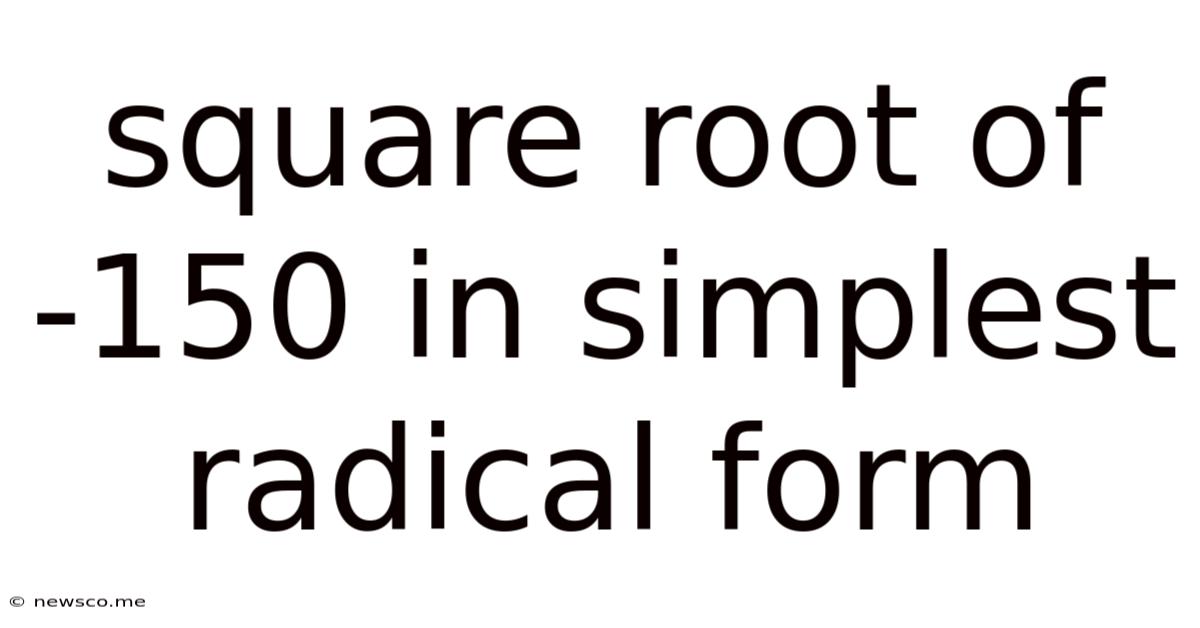Square Root Of -150 In Simplest Radical Form
News Co
Mar 22, 2025 · 4 min read

Table of Contents
Unveiling the Mystery: Simplifying the Square Root of -150
The square root of -150, denoted as √(-150), presents a fascinating challenge in mathematics. Unlike finding the square root of a positive number, this involves venturing into the realm of imaginary numbers, a concept that initially might seem abstract but is fundamental in various fields, including electrical engineering, quantum mechanics, and signal processing. This comprehensive guide will walk you through the process of simplifying √(-150) into its simplest radical form, offering a deep dive into the underlying principles and techniques. We'll explore the key concepts, break down the steps, and illuminate the beauty and logic within imaginary numbers.
Understanding Imaginary Numbers
Before we embark on simplifying √(-150), let's lay a solid foundation by understanding the concept of imaginary numbers. The square root of a negative number is not a real number; it's an imaginary number. The fundamental building block of imaginary numbers is the imaginary unit, denoted as 'i', which is defined as:
i = √(-1)
This seemingly simple definition opens up a whole new dimension in mathematics. Multiplying i by itself results in:
i² = (√(-1))² = -1
This property is crucial in simplifying expressions involving imaginary numbers.
Breaking Down the Problem: √(-150)
Now, let's tackle the square root of -150. Our goal is to express it in the simplest radical form, meaning we want to remove any perfect square factors from under the square root symbol. We can approach this using the properties of radicals:
√(ab) = √a * √b (for non-negative a and b)
and, extending this to imaginary numbers:
√(-a) = √(-1) * √a = i√a (for positive a)
Applying this to our problem:
√(-150) = √(-1 * 150) = √(-1) * √150 = i√150
Simplifying the Radical: √150
We've successfully extracted the imaginary unit 'i', leaving us with √150. Now, we need to simplify this radical. To do this, we find the prime factorization of 150:
150 = 2 * 3 * 5²
Notice the perfect square, 5². We can rewrite √150 as:
√150 = √(2 * 3 * 5²) = √(5² * 2 * 3) = √(5²) * √(2 * 3) = 5√6
The Final Answer: Simplest Radical Form
Combining our results, we have:
√(-150) = i√150 = i * 5√6 = 5i√6
Therefore, the simplest radical form of the square root of -150 is 5i√6. This form is elegant and concise, representing the imaginary number in its most simplified form.
Complex Numbers: A Broader Perspective
The result, 5i√6, is a complex number. Complex numbers are numbers that have both a real and an imaginary part. They are generally expressed in the form:
a + bi
where 'a' is the real part, and 'b' is the imaginary part. In our case, a = 0 and b = 5√6, so our complex number is purely imaginary.
Practical Applications of Imaginary and Complex Numbers
While imaginary numbers might seem abstract at first glance, they have profound practical applications across various fields:
1. Electrical Engineering:
Imaginary numbers are essential in analyzing alternating current (AC) circuits. Impedance, a measure of opposition to the flow of current, is often represented as a complex number, allowing engineers to handle both resistance and reactance (due to inductors and capacitors) simultaneously.
2. Quantum Mechanics:
Quantum mechanics relies heavily on complex numbers to describe the wave function of particles. The wave function, a mathematical description of the particle's state, is often a complex number, and its square magnitude represents the probability of finding the particle at a particular location.
3. Signal Processing:
Imaginary numbers are crucial in representing signals in the frequency domain using the Fourier transform. This transformation allows engineers to analyze signals and manipulate their frequency components, leading to applications like noise reduction and image compression.
4. Mathematics and Physics:
Beyond these specific applications, complex numbers provide a powerful tool within higher-level mathematics and theoretical physics, revealing patterns and simplifying complex computations.
Further Exploration: Advanced Techniques
While we simplified √(-150) using fundamental techniques, more complex expressions involving multiple imaginary numbers might necessitate using additional techniques such as:
-
Complex Conjugates: Multiplying a complex number by its conjugate (changing the sign of the imaginary part) can eliminate the imaginary part from the denominator of a fraction.
-
Euler's Formula: This remarkable formula connects exponential functions with trigonometric functions using imaginary numbers: e^(ix) = cos(x) + i sin(x). This allows for elegant representation and manipulation of complex numbers in various applications.
-
Polar Form: Representing complex numbers in polar form (using magnitude and angle) simplifies multiplication and division operations.
Conclusion: Mastering Imaginary Numbers
Understanding and simplifying expressions involving imaginary numbers like √(-150) is a fundamental skill in mathematics with wide-ranging applications. By mastering the concepts and techniques explained in this article, you’ll not only be able to confidently tackle similar problems but also gain a deeper appreciation for the power and elegance of complex numbers within various scientific and engineering disciplines. Remember, the key is breaking down complex expressions into simpler parts, utilizing the properties of radicals and imaginary numbers, and expressing the final answer in its simplest, most concise form. The journey into the world of imaginary numbers is just beginning!
Latest Posts
Related Post
Thank you for visiting our website which covers about Square Root Of -150 In Simplest Radical Form . We hope the information provided has been useful to you. Feel free to contact us if you have any questions or need further assistance. See you next time and don't miss to bookmark.